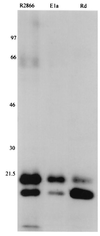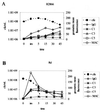Serum resistance in an invasive, nontypeable Haemophilus influenzae strain
- PMID: 11159957
- PMCID: PMC97941
- DOI: 10.1128/IAI.69.2.695-705.2001
Serum resistance in an invasive, nontypeable Haemophilus influenzae strain
Abstract
A common feature of many different organisms causing bacteremia is the ability to avoid the bactericidal effects of normal human serum. In Haemophilus influenzae encapsulated strains are particularly serum resistant; however, we found that a nonencapsulated strain (R2866) isolated from the blood of an immunocompetent child with meningitis who had been successfully immunized with H. influenzae type b conjugate vaccine was serum resistant. Since serum resistance usually involves circumventing the action of the complement system, we defined the deposition of various complement components on the surfaces of this H. influenzae strain (R2866), a nonencapsulated avirulent laboratory strain (Rd), and a virulent type b encapsulated strain (Eagan). Membrane attack complex (MAC) accumulation correlated with the loss of bacterial viability; correspondingly, the rates of MAC deposition on the serum-sensitive strain Rd and the serum-resistant strains differed. Analysis of cell-associated immunoglobulin G (IgG), C1q, C3b, and C5b indicated that serum-resistant H. influenzae prevents MAC accumulation by delaying the synthesis of C3b through the classical pathway. Among the initiators of the classical pathway, IgG deposition contributes most of the C3 convertase activity necessary to start the cascade ending with MAC deposition. Despite similar IgG binding, strain R2866 delays C3 convertase activity compared to strain Rd. We conclude that strain R2866 can persist in the bloodstream, in part by inhibiting or delaying C3 deposition on the cell surface, escaping complement mediated killing.
Figures











Similar articles
-
lgtC expression modulates resistance to C4b deposition on an invasive nontypeable Haemophilus influenzae.J Immunol. 2007 Jan 15;178(2):1002-12. doi: 10.4049/jimmunol.178.2.1002. J Immunol. 2007. PMID: 17202363
-
Role of lgtC in resistance of nontypeable Haemophilus influenzae strain R2866 to human serum.Infect Immun. 2006 Nov;74(11):6226-35. doi: 10.1128/IAI.00722-06. Epub 2006 Sep 11. Infect Immun. 2006. PMID: 16966407 Free PMC article.
-
Naturally occurring bactericidal antibodies specific for Haemophilus influenzae lipooligosaccharide are present in healthy adult individuals.Vaccine. 2015 Apr 15;33(16):1941-7. doi: 10.1016/j.vaccine.2015.02.060. Epub 2015 Mar 1. Vaccine. 2015. PMID: 25738817
-
The role of complement in the host's defense against Haemophilus influenzae.J Infect Dis. 1992 Jun;165 Suppl 1:S62-5. doi: 10.1093/infdis/165-supplement_1-s62. J Infect Dis. 1992. PMID: 1588179 Review.
-
Haemophilus influenzae and the complement system.Trends Microbiol. 2010 Jun;18(6):258-65. doi: 10.1016/j.tim.2010.03.007. Trends Microbiol. 2010. PMID: 20399102 Review.
Cited by
-
Systemic humoral immunity to non-typeable Haemophilus influenzae.Clin Exp Immunol. 2008 Sep;153(3):376-84. doi: 10.1111/j.1365-2249.2008.03697.x. Clin Exp Immunol. 2008. PMID: 18803761 Free PMC article.
-
Molecular basis of increased serum resistance among pulmonary isolates of non-typeable Haemophilus influenzae.PLoS Pathog. 2011 Jan 6;7(1):e1001247. doi: 10.1371/journal.ppat.1001247. PLoS Pathog. 2011. PMID: 21253576 Free PMC article.
-
Shielding of a lipooligosaccharide IgM epitope allows evasion of neutrophil-mediated killing of an invasive strain of nontypeable Haemophilus influenzae.mBio. 2014 Jul 22;5(4):e01478-14. doi: 10.1128/mBio.01478-14. mBio. 2014. PMID: 25053788 Free PMC article.
-
Binding of human factor H to outer membrane protein P5 of non-typeable Haemophilus influenzae contributes to complement resistance.Mol Microbiol. 2014 Oct;94(1):89-106. doi: 10.1111/mmi.12741. Epub 2014 Aug 18. Mol Microbiol. 2014. PMID: 25091181 Free PMC article.
-
Binding of complement regulators to invasive nontypeable Haemophilus influenzae isolates is not increased compared to nasopharyngeal isolates, but serum resistance is linked to disease severity.J Clin Microbiol. 2010 Mar;48(3):921-7. doi: 10.1128/JCM.01654-09. Epub 2010 Jan 20. J Clin Microbiol. 2010. PMID: 20089757 Free PMC article.
References
-
- Anonymous. Progress toward eliminating Haemophilus influenzae type b disease among infants and children—United States, 1987–1997. JAMA. 1999;281:409–410. - PubMed
-
- Apicella M A, Griffiss J M, Schneider H. Isolation and characterization of lipopolysaccharides, lipooligosaccharides, and lipid A. Methods Enzymol. 1994;235:242–252. - PubMed
-
- Brophy L N, Kroll J S, Ferguson D J, Moxon E R. Capsulation gene loss and ‘rescue’ mutations during the Cap+ to Cap− transition in Haemophilus influenzae type b. J Gen Microbiol. 1991;137:2571–2576. - PubMed
Publication types
MeSH terms
Substances
Grants and funding
LinkOut - more resources
Full Text Sources
Other Literature Sources
Molecular Biology Databases
Miscellaneous

